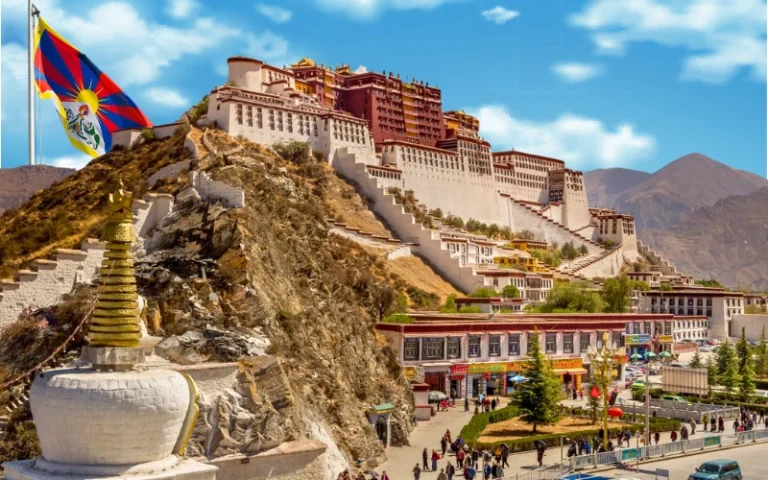They say prayers whispered from mountaintops reach heaven faster. Now imagine a palace so tall, so sacred, that it touches both history and heaven — welcome to the Potala Palace.
Set 12,000 feet above sea level in Lhasa, Tibet, this magnificent structure isn’t just an architectural wonder — it is a spiritual emblem, a political stronghold, and a timeless keeper of Buddhist heritage. For centuries, the Potala Palace served as the winter residence of the Dalai Lama and the epicenter of Tibet’s religious and administrative life.
This article brings you a full picture of the Potala Palace — how it was built, what it holds inside, why it matters, and 12 fascinating facts that showcase its global and spiritual relevance.
Key Stats: A Glimpse at the Grandeur
| Attribute | Detail |
|---|---|
| Location | Lhasa, Tibet |
| Altitude | 3,700 meters (12,139 feet) |
| Construction Started | 1645 |
| Completed | 1694 |
| Total Stories | 13 |
| Number of Rooms | Over 1,000 |
| Shrines | Approx. 10,000 |
| Statues | Nearly 200,000 |
| Height from Base | 117 meters |
| UNESCO World Heritage Status | Since 1994 |
The origins of the Potala Palace trace back to the 7th century. King Songtsen Gampo originally constructed a palace on Red Hill to celebrate his marriage to Chinese Princess Wencheng. However, the grandeur we see today came into existence in the 17th century under the guidance of the Fifth Dalai Lama, Ngawang Lobsang Gyatso.
He envisioned the Potala as a symbol of Buddhist spiritual power and Tibetan political authority. The construction took decades, employing artisans, monks, and workers from across the Himalayas.
The Origins: From Myth to Monument
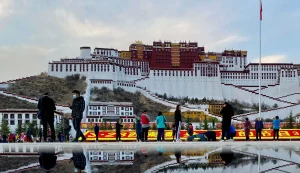
The name Potala Palace is derived from Mount Potalaka, the mythical abode of Avalokiteshvara, the bodhisattva of compassion. Tibetan tradition holds that King Songtsen Gampo, the 33rd king of Tibet, meditated in sacred caves on the hill where the palace now stands during the 7th century. He built the first palace on this site, which remains a spiritual cornerstone to this day.
The Vision of the Fifth Dalai Lama
The grand structure we see today was initiated by the Fifth Dalai Lama in 1645. He envisioned a palace that would unify religious and political power in Tibet, strategically placed between the great monasteries of Drepung and Sera, overlooking Lhasa. The palace became the seat of Tibetan government and the spiritual home of the Dalai Lamas.
Architectural Marvel: Building the Potala Palace
White Palace and Red Palace
The Potala Palace is divided into two main parts:
-
White Palace (Potrang Karpo): This section served as the Dalai Lama’s living quarters and administrative center. It was completed in 1648 and is characterized by its bright white walls.
-
Red Palace (Potrang Marpo): Dedicated to religious study and worship, this section was completed decades later and houses chapels, libraries, and sacred relics.
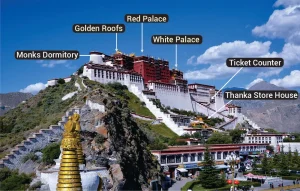
| Component | Description |
|---|---|
| White Palace | Residential area for the Dalai Lama; includes offices, schools, and dormitories |
| Red Palace | Spiritual heart; houses stupas, chapels, and scripture halls |
| Golden Roofs | Symbol of sacredness and protection; also serve as lightning conductors |
| Inner Courtyards | Spaces designed for meditation, gatherings, and sacred rituals |
| Watch Towers | Provide panoramic views of Lhasa; serve as protective lookout points |
Construction Feats
The palace’s construction was a monumental task. The exterior walls took just three years to build, but the intricate interiors and decorations took over four decades. The palace rises thirteen stories high, containing more than a thousand rooms, tens of thousands of statues, and thousands of shrines.
Its walls are incredibly thick, up to three meters in some places, and the foundation is reinforced with copper to withstand earthquakes—a testament to the builders’ foresight.
Design and Symbolism
The palace covers an area roughly 400 meters by 350 meters. The White Palace symbolizes secular governance and peace, while the Red Palace represents spiritual authority. The entire complex is a masterpiece of Tibetan architecture, blending functionality with deep religious symbolism.
Spiritual Center: The Heart of Tibetan Buddhism
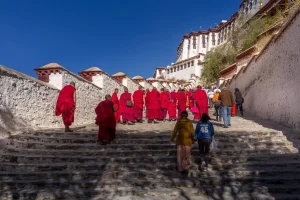
Residence of the Dalai Lamas
For centuries, the Potala Palace was the winter residence of the Dalai Lamas, Tibet’s spiritual and political leaders. It contains the tombs of eight Dalai Lamas, each enshrined in magnificent golden stupas.
Sacred Chapels and Artifacts
The palace holds numerous chapels filled with priceless Buddhist scriptures, ancient thangkas (religious paintings), and statues. Among these treasures is the revered Arya Lokeshvara statue, embodying compassion.
Pilgrims from across Tibet and beyond journey here to pay respects and seek spiritual blessings, making the palace a vital pilgrimage destination.
Religious Significance: Heart of Tibetan Buddhism
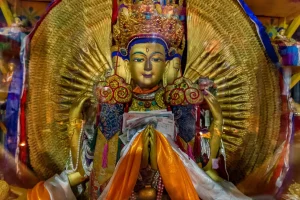
The Potala Palace is not just a monument; it’s a living center of spiritual energy. Within its walls reside thousands of Buddhist scriptures, relics, and sacred art pieces. Pilgrims from all over the world come to offer prayers, walk the kora (circumambulation), and feel the sacred vibrations.
Even today, monks conduct rituals and chants inside the Red Palace, maintaining a spiritual continuity that has existed for centuries.
Rituals Performed Inside Potala Palace
| Ritual Name | Frequency | Purpose & Significance |
|---|---|---|
| Morning Chanting | Daily | Performed by monks to purify the palace’s energy and invoke blessings |
| Butter Lamp Offering | Daily | Symbol of light and wisdom; placed before sacred images and scriptures |
| Great Prayer Festival | Annually (Feb) | Held to celebrate Buddha’s miracles; involves mass prayers and debates |
| Mandala Construction | Occasionally | Spiritual geometry created with colored sand, later offered to deities |
| Sacred Scripture Recital | Monthly | Reading of ancient texts like Kangyur to preserve oral lineage |
Political Importance: Seat of Power
Before the Dalai Lama’s exile in 1959, the Potala Palace was Tibet’s political capital. It was from here that state matters, international relations, and religious guidance were managed.
The palace acted as a strategic stronghold, with its high altitude offering a commanding view of the surrounding city of Lhasa. Its sheer inaccessibility symbolized the strength and autonomy of Tibet.
Historical Timeline: From the Seventh Century to Today
-
7th Century: King Songtsen Gampo constructs the original palace on Marpo Ri hill.
-
1645: The Fifth Dalai Lama begins building the current palace.
-
1648: Completion of the White Palace.
-
1694: Completion of the Red Palace.
-
Early 20th Century: Renovations and expansions by the 13th Dalai Lama.
-
1959: The 14th Dalai Lama flees during the Tibetan uprising, marking the end of the palace’s political role.
-
1994: The palace is designated a UNESCO World Heritage site.
Mysteries and Legends: The Untold Stories
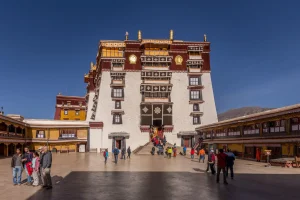
Secret Passages and Hidden Rooms
Stories tell of secret tunnels beneath the palace that connect it to other sacred sites in Lhasa. While some passages exist, many remain undiscovered, adding to the palace’s aura of mystery.
The Meditation Caves
The original caves where King Songtsen Gampo meditated are preserved inside the palace. These sacred spaces are believed to hold powerful spiritual energy and continue to attract devoted pilgrims.
The Dalai Lama’s Escape
In 1959, the 14th Dalai Lama escaped from the palace amid political turmoil, an event that transformed Tibetan history and elevated the palace’s symbolic importance.
Sacred Artifacts Preserved Inside Potala Palace
| Artifact Type | Quantity/Presence | Cultural or Spiritual Significance |
|---|---|---|
| Mummified Stupas | 8 (of previous Dalai Lamas) | Serve as holy relics enshrined in gold and precious stones |
| Ancient Scriptures | Over 40,000 texts | Includes Kangyur & Tengyur, handwritten and block-printed in Sanskrit |
| Thangka Paintings | Hundreds | Used for meditation, ceremonies, and storytelling of Buddhist epics |
| Bronze Statues | Nearly 200,000 | Represent Buddhas, Bodhisattvas, protectors, and lineage masters |
| Ritual Instruments | Dozens in use | Conch shells, drums, bells, and dorjes used in daily and festival rituals |
Potala Palace in Numbers: Fascinating Facts
-
Over 7,000 workers and 1,500 artists contributed to its construction.
-
The palace contains more than 200,000 statues.
-
It stands 300 meters above the Lhasa valley floor.
-
Copper reinforcements protect the foundation from earthquakes.
-
The main assembly hall can hold hundreds of monks during ceremonies.
Artistic Wonders Inside the Palace
- Murals: Over 700 intricate murals that narrate the lives of Dalai Lamas, Buddhist deities, and Tibetan myths.
- Statues: Nearly 200,000, including those made of gold, copper, wood, and jade.
- Thangkas & Mandalas: Rich tapestries and silk scrolls hang from the walls, serving both as art and spiritual tools.
- Sacred Libraries: Contain texts like the Kangyur and Tengyur, preserved on hand-written and block-printed manuscripts.
The Potala Palace Today: Tourism, Preservation, and Challenges
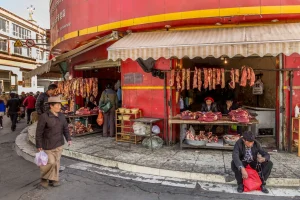
A Magnet for Pilgrims and Tourists
Thousands visit the Potala Palace annually, especially during Tibetan festivals and New Year celebrations. The palace remains a vibrant center of Tibetan culture and spirituality.
Preservation Efforts
Extensive restoration projects have been undertaken to preserve the palace’s structure and priceless artwork. Visitor numbers are strictly controlled to minimize damage from foot traffic and environmental factors.
Challenges
The high altitude and steep stairways can be physically demanding for visitors. Conservationists continue to balance the need for tourism with protecting this fragile heritage site.
The Visitor Experience
Walking through the Potala Palace is like stepping into another world. The golden rooftops shimmer under the Tibetan sun, while the air smells of centuries-old incense.
What to Expect:
- Over 2,000 steps to reach the top.
- Visitors must rest a day before due to high altitude.
- Photography inside is generally prohibited.
- Entry is timed and limited per day to preserve the interiors.
Cultural Symbol & UNESCO Recognition
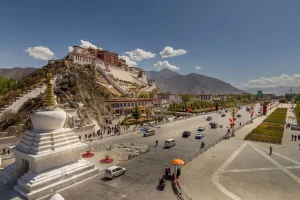
In 1994, the Potala Palace was recognized as a UNESCO World Heritage Site. It symbolizes Tibet’s spiritual traditions and rich history. Along with Jokhang Temple and Norbulingka, it forms a sacred triad of Tibetan culture.
Preservation efforts continue as climate change and tourism pose new threats. Yet, the palace still stands, its gold roofs shining as they have for centuries.
12 Majestic Facts About Potala Palace
- Built without a single iron nail.
- Highest ancient palace on Earth.
- Inspired by Mount Potalaka, home of Avalokitesvara.
- Took over 50 years to complete.
- Built using wood, stone, and clay.
- Fifth Dalai Lama’s tomb is encased in 3,700 kg of gold.
- 13 stories connected by narrow corridors.
- Golden rooftops serve as lightning conductors.
- 300+ monks still reside nearby.
- Wall paintings use natural minerals.
- Palace reflects Buddhist cosmology in its layout.
- Daily rituals are still performed inside.
Conclusion: The Enduring Power of the Potala Palace
The Potala Palace stands as a timeless symbol of Tibetan faith, culture, and endurance. Its soaring walls and sacred halls tell stories of kings and monks, of devotion and power. For anyone drawn to history, spirituality, or architectural beauty, the Potala Palace offers an unforgettable experience.
Trending FAQs about the Potala Palace
Q1: Why is the Potala Palace so famous?
The Potala Palace is famous for its stunning architecture, spiritual significance as the Dalai Lama’s former residence, and its status as a UNESCO World Heritage site.
Q2: Can tourists visit the Potala Palace?
Yes, tourists can visit, but daily visitor numbers are limited to protect the site. Booking in advance is recommended.
Q3: What can visitors see inside the Potala Palace?
Visitors can see chapels, assembly halls, golden stupas, ancient scriptures, religious paintings, and thousands of statues.
Q4: How old is the Potala Palace?
The current palace was built in the 17th century, but the site’s history dates back to the 7th century.
At FameHouseWorld, we celebrate landmarks that shape nations, and Qasr Al Watan stands tall among them as a beacon of heritage, pride, and enduring beauty.
